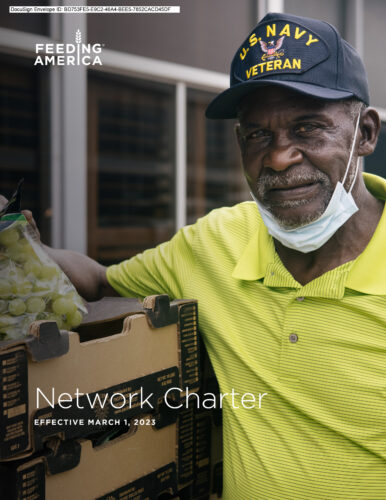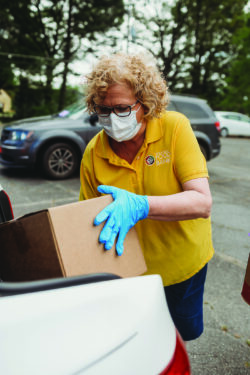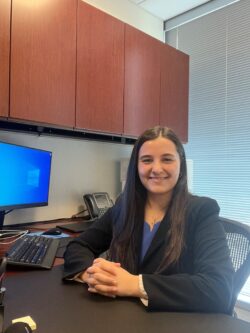In a three-year-long project, Stanford Law School’s (SLS) Organization and Transactions Clinic created a mission-critical suite of contracts for Feeding America, the nation’s largest hunger relief organization.
“This was hands down the most rewarding experience I’ve had in law school,” said SLS student Taylor Beardall, JD ’23, of her experience helping the Feeding America network of food banks and related hunger relief organizations reinvent a suite of contracts underlying their important work. “Not only did I get to work directly with executive team members of the largest hunger relief organization in the country, but I got to contribute to a mission that impacts so many people’s lives,” said Beardall. The new agreements will enable the 200 food banks in the nationwide network to better serve people facing hunger well into the future.

As an advanced clinic student with SLS’s Organizations and Transactions Clinic (O&T Clinic) Beardall and a handful of other students joined the Clinic’s founding director, Jay Mitchell (BA ’80) on different legs of a three-year journey to completely transform the Feeding America network’s governing contracts. One of 11 legal clinics at the law school, the O&T Clinic offers SLS students the opportunity to work on governance, contract, and legal advisory projects for non-profit organizations.
The scale of the Feeding America network’s work is huge: its members provide food to one in seven Americans, totaling 5.2 billion meals last year. According to the United States Department of Agriculture, 34 million people in the United States, including 9 million children, experience food insecurity.
The different types of network members and the many horizontal and vertical relationships within the network with interlocking matrices of rights and obligations made the contracting landscape particularly complex. The network includes nearly 200 partner food banks/independent non-profits that have relationships with each other, 75 affiliate food banks, 21 state associations of food banks, eight regional food purchasing cooperatives, roughly 60,000 points of distribution, and the national organization, Feeding America, based in Chicago.
“This has been one of the true high points of my almost 40 years in practice,” said Mitchell, who prior to joining SLS in 2007 served for 15 years as a senior lawyer at Levi Strauss & Co. Mitchell is retiring from the clinical program at the end of the academic year but will continue to teach at the law school. “I’m deeply grateful that I had this opportunity. I could not imagine a more meaningful project to finish out my many rewarding years leading the O&T Clinic.”
“A Few Ideas”
In the course of projects Mitchell and his clinic students have handled over the years for Bay Area food banks such as the Alameda County Community Food Bank, Mitchell had a number of occasions to review the network’s prior agreement. “I thought there were meaningful opportunities for modernization in terms of both substance and presentation,” he said. “I told our food bank clients I had a few ideas.”

Mitchell’s local relationships led to an introduction, in 2019, to Feeding America. His initial “few ideas” evolved into a three-year-long pro bono engagement for the O&T Clinic. The work resulted in a fully revamped, 135-page, 10-year agreement among Feeding America and the nearly 200 partner food banks, as well as four additional contracts governing relationships between other members of the network. Together, these agreements memorialize the universe of rights and obligations among the various entities, from product sourcing standards and disaster relief protocols to food safety, trademark usage, corporate governance, and tax compliance.
The clinic team also helped create a Network Charter setting out the membership’s shared beliefs and guiding principles, a statement new to the network and central to their work.
The food banks and Feeding America last revised the partner food bank contract in 2014. In 2019, it launched an every-five-years update process, led by a Contract Task Force consisting of 16 food bank and Feeding America executives and co-chaired by two food bank CEOs and the COO and CFO of Feeding America. The task force established subcommittees dedicated to specific topics. The subcommittees involved 120+ participants from across the country.
“A lot has happened since 2014, not the least of which includes COVID. We all remember those long lines of cars outside a food bank,” said Mitchell. “The period also saw an increased and intense focus by the network on DEI, new data collection and analytical tools, new cooperative purchasing vehicles, and all sorts of other important developments. We had to address that, as well as other areas identified by the network as priorities.”
Mitchell said that he and his clinic students have recorded nearly 1,900 hours on the project to date. The new partner food bank agreement went into effect March 1 and Mitchell continues to finalize the other four contracts.
Values-Driven Drafting
“Intellectually, this project was a challenge given the range of topics covered by the contract, the many relationships and stakeholders at play, the way the various contracts needed to fit together, and the many operating and legal issues they needed to cover,” Mitchell said. “It also presented real design and organizational issues in light of both the wide-ranging content and the fact that staff from multiple functions across a food bank need to reference the document. And the contract needed to be approved through a 2/3 vote of the partner food banks. But obviously it is the importance of the mission and work of the network that gave this engagement special meaning.”
“What struck me over and over, working with food bank leaders from all over the country who were part of the contract task force, was that these are all people of genuine good will, with extraordinary dedication to their mission,” Mitchell continued. “We kept coming back to the values set out at the beginning of the project, always trying to reflect those values through the contract.”
The Network Charter begins with the statement that the members of the Network “are unified by a common vision of an America where no one is hungry.” Words like “sharing,” “empathy,” and “dignity” pepper the document. Paramount in all conversations and considerations, Mitchell said, was a focus on one overarching goal: how to best serve people facing hunger.
The Contract Task Force circulated a draft of the partner food bank contract in March 2022. They received more than 1,300 comments from the food banks and other stakeholders within the network. In reporting back to the members, the task force said “we read, cataloged, reviewed, and discussed every single comment.” Mitchell and his students revised the document in response to those comments, Feeding America circulated a new draft in September, and the food banks approved the new contract in January 2023.
“The Stanford Law Clinic was such a vital partner over the last three years,” said Kathryn Strickland, chief network officer at the Feeding America national organization. “Guided by their dedication and expertise, we’ve built an agreement together that will shepherd this expansive and diverse network through the next decade. This was not just a red-lining exercise; it was a complete overhaul. We’ve built this contract as one network, jointly committed to our values of equity, diversity and inclusion, and centered on the voices of people facing hunger.”
New Contract, New Opportunities to Help People Facing Hunger

“Transformational” and “exciting” are just some of the words recently retired CEO of the Arkansas Food Bank Rhonda Sanders used to describe the new group of contracts. Sanders was one of the co-chairs of the Contract Task Force.
“For those of us in the Feeding America network, our contract is our guiding light,” Sanders said. “As the network has grown and matured since the 1970s, we have never had anything close to this level of attention to the contract. Now, with clear guidance and a governing set of principles—including how we can be more efficient about sharing resources, how we resolve conflicts, and how we work collaboratively—we are better positioned to serve people facing hunger. For example, we always shared surplus food and resources, but it was ad hoc and not always efficient. The contracts and the accompanying Network Charter set forth clear guidelines and set us up for mutual success.”

Zack Wilson, executive director of the High Plains Food Bank in Amarillo, Texas, said he “shudders to think” how the contract revision would have gone without the clinic’s support. “Jay wasn’t just the lawyer who drafted the language and flagged issues, he was really the master facilitator of the project. He challenged us all the time and made us ask ourselves important questions about who we are and how we can all best work together,” said Wilson, who co-chaired the Contract Task Force with Sanders.
Wilson added that the Network Charter, which sets forth the guiding principles and values for the network, has helped the geographically diverse food banks feel a common purpose and uniting set of principles. “There’s a new energy in our collaborations, a sense that we are all in this together,” he said. “This energy and shared purpose ultimately will allow us to better achieve our goal of feeding the nation’s hungry.”
‘Rewarding Experience’ for Students—and the Instructor

“I’m so grateful for everything I learned through this experience, from the legal aspects, such as how to create a complicated network of documents that ultimately form one comprehensive contract, to learning about the inner workings of food banks which are incredibly complex,” O&T Clinic student Beardall said. “I found the sourcing/operational aspects of running a successful food bank network to be fascinating.”
Natalie Cernius, JD ’22, now an associate in the Irvine office of Gibson, Dunn & Crutcher LLP, was similarly enthusiastic about the experience. “When I joined the contract project, I did not fully grasp its scope and scale. I quickly came to appreciate what a massive undertaking this was, and what a privilege it was to be a part of a project with potential to make a meaningful difference. Being part of this project is, and will remain, one of the great honors of my career.”

Cernius said she “learned to keep in mind that a contract is a working document, something that people are actually going to read and use. In making both formatting and content decisions, considering the audience and what would make the contract work best for them, had to be top of mind,” she said. “The audience, in this case, were 200 food banks in diverse geographic locations and the Feeding America national organization, each with their own unique needs and interests, making it a particularly tricky puzzle. The structure and presentation of the contract that Jay came up with was so thoughtful and completely transformed what the client started with.”
Mitchell said he hopes to maintain a relationship with Feeding America after his retirement. “It’s a huge privilege to work for those folks,” he said. “If I can help out, I’d love to keep it going.”
About the Organizations and Transactions Clinic
One of 11 clinical education opportunities under the umbrella of Stanford Law School’s renown Mills Legal Clinic, the Organizations and Transactions Clinic offers students the opportunity to handle corporate and transactional work for the clinic’s clients, all of whom are established nonprofit corporations, include national leaders in hunger relief, the performing and visual arts, science education, agriculture, and other fields. The clinic also maintains a resource website, targeted to lawyers engaging in pro bono work, that contains approximately 275 forms and model legal documents for nonprofits.
About Stanford Law School
Stanford Law School is one of the nation’s leading institutions for legal scholarship and education. Its alumni are among the most influential decision makers in law, politics, business, and high technology. Faculty members argue before the Supreme Court, testify before Congress, produce outstanding legal scholarship and empirical analysis, and contribute regularly to the nation’s press as legal and policy experts. Stanford Law School has established a model for legal education that provides rigorous interdisciplinary training, hands-on experience, global perspective, and focus on public service, spearheading a movement for change.





